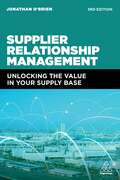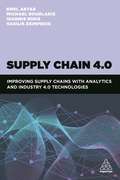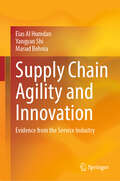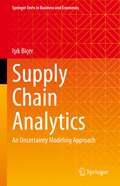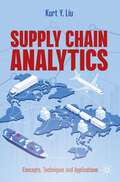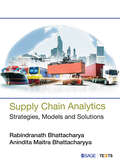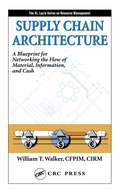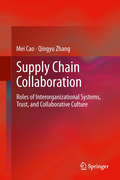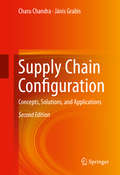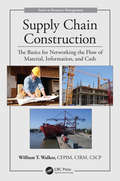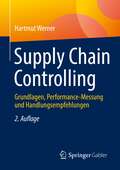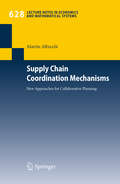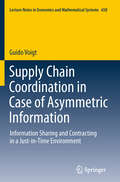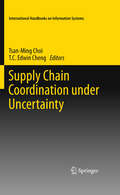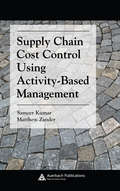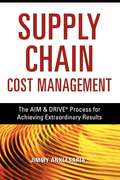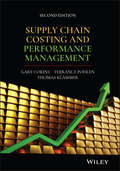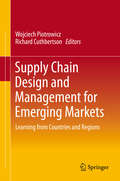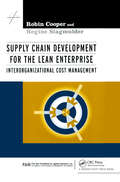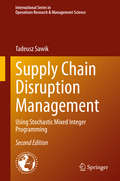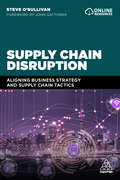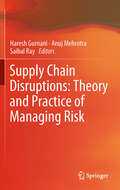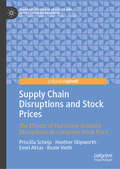- Table View
- List View
Supplier Relationship Management: Unlocking the Value in Your Supply Base
by Jonathan O'BrienEffective supplier relationship management enables organizations to unlock value from their supply base and reap tangible benefits. With practical tips and a proven approach, this is the guide to understanding how to maximize the potential of suppliers to gain a competitive advantage, get more innovation and drive sustainability.Supplier Relationship Management explains the importance of ongoing supplier management, how to measure and improve their performance, and for the critical few that can make a dramatic difference to our organization, drive in and future-proof strategic collaborative relationships. The Orchestra of SRM® framework, coupled with expert tips, tools and resources, delivers clear guidance on how to design an effective supplier relationship management program, with maximum return on time and investment.Written by leading procurement expert, Jonathan O'Brien, this third edition offers new content on how to adapt to the huge changes we have seen across supply bases in recent years, and the new risks and challenges organizations face in managing key suppliers. It includes new information on driving sustainability, the future of the supply base, and how to secure more innovation from our suppliers. Supplier segmentation is outlined in more detail and there is new information on how companies are managing supply chains, and the impacts of this in practice. A practical guide to unlock the new value from your key suppliers in a changing world.
Supplies Management for Health Services (Routledge Revivals)
by Stanley HymanFirst published in 1979, Supplies Management for Health Services looks at the characteristics and problems of hospital suppliers and examines the way in which the hospital and the National Health Service deal with supplies problems and relations with suppliers. Beginning with a description of the National Health Service and its supplies’ organisations and the role of the Department of Health and Social Security in this field, the book then reports on the detailed studies made over two years of the supplies’ problems of ten London area health authorities and ten London manufacturers of medical equipment. The NHS situation is then contrasted with the supplies’ situation in three non-health organisations and with the health supplies situation in France and West Germany. The final part of the book analyses the information obtained, proposes a means of assessing supplies systems, and evaluates the NHS situation. This is followed by the realistic proposals for reform, advocating a system similar to that used in British defence services, based on a central procurement agency, close cooperation with private manufacturers, and manufacture by government where necessary. This book will surely interest students of economics and global health.
Supply Chain 4.0: Improving Supply Chains with Analytics and Industry 4.0 Technologies
by Vasileios Zeimpekis Ioannis Minis Dr Emel Aktas Professor Michael Bourlakis'Supply Chain 4.0' has introduced automation into logistics and supply chain processes, exploiting predictive analytics to better match supply with demand, optimizing operations and using the latest technologies for the last mile delivery such as drones and autonomous robots. Supply Chain 4.0 presents new methods, techniques, and information systems that support the coordination and optimization of logistics processes, reduction of operational costs as well as the emergence of entirely new services and business processes.This edited collection includes contributions from leading international researchers from academia and industry. It considers the latest technologies and operational research methods available to support smart, integrated, and sustainable logistics practices focusing on automation, big data, Internet of Things, and decision support systems for transportation and logistics. It also highlights market requirements and includes case studies of cutting-edge applications from innovators in the logistics industry.
Supply Chain Agility and Innovation: Evidence from the Service Industry
by Eias Al Humdan Yangyan Shi Masud BehniaThis book critically examines the concept of 'supply chain agility' (SCA) in a novel context, shedding light on its implications for executives and professionals. While much literature has explored SCA in manufacturing, this book pioneers a comprehensive exploration of its application in the service sector, an often-overlooked domain in operations management, supply chain management, and innovation literature. The analysis, based on data from 245 service firms in Australia, employs a unique approach, revealing a positive relationship between firm innovativeness and SCA, with SCA in turn positively impacting firm performance. By bridging gaps in previous research, this book offers conceptual, methodological, and empirical contributions, emphasizing the critical role of innovation in achieving SCA, particularly in uncertain contexts. It provides valuable insights for firms navigating the service economy, offering a holistic examination of the benefits of SCA and empirically validating its role in managing market changes cost-effectively for a competitive advantage. The findings encourage a re-evaluation of firm performance, urging business professionals and managers to adopt a comprehensive perspective. The insights presented serve as a valuable tool for measurement, estimation, assessment, and benchmarking—key drivers for improving and predicting performance in dynamic supply chain environments. Overall, this book is a timely and essential resource for those seeking to understand and enhance supply chain agility in the evolving landscape of the service industry.
Supply Chain Analytics: An Uncertainty Modeling Approach (Springer Texts in Business and Economics)
by Işık BiçerThis textbook offers a detailed account of analytical models used to solve complex supply chain problems. It introduces a unique risk analysis framework that helps the reader understand the sources of uncertainties and use appropriate models to improve decisions in supply chains. This framework illustrates the complete supply chain for a product and demonstrates the supply chain's exposure to demand, supply, inventory, and financial risks. Step by step, this book provides a detailed examination of analytical methods that optimize operational decisions under different types of uncertainty. It discusses stochastic inventory models, introduces uncertainty modeling methods, and explains methods for managing uncertainty. To help readers deepen their understanding, it includes access to various supplementary material including an online interactive tool in Python. This book is intended for undergraduate and graduate students of supply chain management with a focus on supply chain analytics. It also prepares practitioners to make better decisions in this field.
Supply Chain Analytics: Concepts, Techniques and Applications
by Kurt Y. LiuThis innovative new core textbook, written by an experienced professor and practitioner in supply chain management, offers a business-focused overview of the applications of data analytics and machine learning to supply chain management. Accessible yet rigorous, this text introduces students to the relevant concepts and techniques needed for data analysis and decision making in modern supply chains and enables them to develop proficiency in a popular and powerful programming software. Suitable for use on upper-level undergraduate, postgraduate and MBA courses in supply chain management, it covers all of the major supply chain processes, including managing supply and demand, warehousing and inventory control, transportation and route optimization. Each chapter comes with practical real-world examples drawn from a range of business contexts, including Amazon and Starbucks, case study discussion questions, computer-assisted exercises and programming projects.
Supply Chain Analytics: Strategies, Models and Solutions
by Rabindranath Bhattacharya Anindita M. BhattacharyyaAn easy-to-read textbook that will help students to understand and appreciate the concepts and decision-making processes of supply chain management through analytics. This book presents the concepts, strategies and models related to supply chains. Using accessible quantitative models, it provides a unified framework for supply chain analytics for products - right from sourcing to manufacturing to delivery to remanufacturing, which closes the supply chain. The book synthesizes a collection of analytical models in the context of both formulation and solution of the problems in all the areas of supply chain. The textbook provides its readers with the tools and skills necessary to understand supply chains analytically and quantitatively and opens opportunities for them to play around with the concepts through exercises and examples. This book will be ideal for students of management who want to get a better understanding of supply chain analytics. Key Features: • Contains over 10 case studies of real Indian companies - their supply chain problems and solutions • Includes sections on system dynamic models, stochastic models and chapters on remanufacturing models and simulation modelling • Uses Microsoft Excel solver to help students easily grasp the mathematics behind the models and experiment with the problems themselves.
Supply Chain Architecture: A Blueprint for Networking the Flow of Material, Information, and Cash (Resource Management)
by William T. Walker"The book is highly readable, informative, thought provoking, and educational.At every stage, Walker challenges the reader to move away from conventional supply chain thinking to a broader-view, highly concise approach that focuses on the organization's objectives. The book will help you visualize a supply network and develop a blueprint for your
Supply Chain Close-Up: The Video Vault
by V. G. Narayanan Lisa BremThe owners of the Video Vault struggle to determine the optimal stocking levels of home videos in an industry fraught with new technology, new pricing paradigms, and stiff competitive pressure from large national chains. Teaching Purpose: To demonstrate the role of incentive contracts in achieving supply chain coordination.
Supply Chain Collaboration
by Qingyu Zhang Mei CaoTo survive and thrive in the competition, firms have strived to achieve greater supply chain collaboration to leverage the resources and knowledge of suppliers and customers. Internet based technologies, particularly interorganizational systems, further extend the firms' opportunities to strengthen their supply chain partnerships and share real-time information to optimize their operations. Supply Chain Collaboration: Roles of Interorganizational Systems, Trust, and Collaborative Culture explores the nature and characteristics, antecedents, and consequences of supply chain collaboration from multiple theoretical perspectives. Supply Chain Collaboration: Roles of Interorganizational Systems, Trust, and Collaborative Culture conceptualizes supply chain collaboration as seven interconnecting elements including information sharing, incentive alignment, goal congruence, decision synchronization, resource sharing, as well as communication and joint knowledge creation. These seven components define the occurrence of collaborative efforts and allow us to explain supply chain collaboration more precisely. Collaborative advantages are also divided into five components to capture the joint competitive advantages and benefits among supply chain partners. The definitions and measures developed here examine some central issue surrounding supply chain development but this is also followed up with real-life managerial practicalities. This balance of theory and practical application makes Supply Chain Collaboration: Roles of Interorganizational Systems, Trust, and Collaborative Culture a strong resource for industry practitioners and researchers alike.
Supply Chain Configuration
by Charu Chandra Janis GrabisThis book discusses the models and tools available for solving configuration problems, emphasizes the value of model integration to obtain comprehensive and robust configuration decisions, proposes solutions for supply chain configuration in the presence of stochastic and dynamic factors, and illustrates application of the techniques discussed in applied studies. It is divided into four parts, which are devoted to defining the supply chain configuration problem and identifying key issues, describing solutions to various problems identified, proposing technologies for enabling supply chain confirmations, and discussing applied supply chain configuration problems. Its distinguishing features are: an explicit focus on the configuration problem an in-depth coverage of configuration models an emphasis on model integration and application of information modeling techniques in decision-making New to this edition is Part II: Technologies, which introduces readers to various technologies being utilized for supply chain configuration and contains two new chapters. The volume also has an added emphasis on the most recent theoretical developments and empirical findings in the area of supply chain management and related topics. This book is appropriate for professional and technical readers, including research directors, research associates, and institutions involved in both the design and implementation of logistics systems in manufacturing and service-related products. An equally appropriate audience is the academic reader, including professors, research associates, and students in industrial, manufacturing, mechanical, and automotive engineering departments, as well as engineering management, management sciences, and production and operations management.
Supply Chain Construction: The Basics for Networking the Flow of Material, Information, and Cash (Resource Management)
by William T. WalkerAll too often, entrepreneurs start small businesses unaware of their need for a supply chain network. And, large companies are acquired and their product lines merged with little regard for supply chain network integration and rationalization. Written for practitioners by a practitioner with 40 years of experience, Supply Chain Construction: The Ba
Supply Chain Controlling: Grundlagen, Performance-Messung und Handlungsempfehlungen
by Hartmut WernerDas Supply Chain Controlling ermöglicht es, die Bereiche zur Kostensenkung innerhalb moderner Lieferketten aufzudecken. In diesem Buch wird eine Ausgestaltung des Supply Chain Controllings aufgezeigt. Zu den Instrumenten zählen Kennzahlensysteme und Werttreiberbäume. Außerdem werden moderne Performance-Measurement-Systeme vorgestellt, wie beispielsweise die Supply Chain Scorecard. Abweichungen zu gesetzten Zielvorgaben lassen sich über ein Cost Tracking geeigneter Spitzenwerte sowie moderne Hard-(Soft)-Analysen messen. Aber auch das Working Capital Management und Konzepte des Strategischen Kostenmanagements (Target Costing, Prozesskostenrechnung, Lifecycle Costing, Total-Cost-of-Ownership) gehören dazu. Schließlich trägt wohl kein anderer Bereich zu einer dauerhaften Wertsteigerung von Organisationen bei, wie die Wertschöpfungskette, deren Effekte sich über den Economic Value Added messen lassen.Die 2. Auflage wurde vollständig überarbeitet und erweitert mit neuen Kapiteln zu den aktuellen Untersuchungsbereichen Digitales Supply Chain Controlling und Resilientes Supply Chain Controlling.
Supply Chain Coordination Mechanisms
by Martin AlbrechtIntegrated supply chain planning is well understood by theory and widely applied in practice - however, only with respect to intra-organisational supply chains. In inter-organisational supply chains, an additional, yet unresolved problem arises: due to confidentiality reasons, decentralized parties keep their local data private, which prevents an integrated planning. Local planning procedures such as upstream planning, which are usually applied then, result in suboptimal solutions for the supply chain as a whole. In this work, new mechanisms for inter-organizational, collaborative supply chain planning are presented. These mechanisms are able to identify the systemwide optimum for several classes of supply chain planning problems. They can be applied by two or more self-interested parties and do not require a trusted third party. Extensive computational tests for randomly generated and real-word data suggest a favorable performance of these mechanisms.
Supply Chain Coordination in Case of Asymmetric Information
by Guido VogtInformation sharing is frequently promoted as a mean to improve the supply chain performance. This work shows the results of behavioral experiments, in which the participants share private information in order to influence the contract terms in a Just-in-Time environment. It is shown that the impact of information sharing is ambiguous, and dependent on several factors, such as contract flexibility and complexity or the interacting behavioral types. The experimental results form the basis for a behavioral principal-agent model that gives valuable insights on how the interaction of trust, trustworthiness and the information sharing strategy impacts the supply chain performance.
Supply Chain Coordination under Uncertainty
by T.C. Edwin Cheng Tsan-Ming ChoiChannel coordination is a core subject of supply chain management. Over the past decade, much research effort has been devoted to exploring the detailed mechanisms for achieving supply chain coordination under uncertainty, generating many fruitful analytical and empirical results. Despite the abundance of research results, there is an absence of a comprehensive reference source that provides state-of-the-art findings on both theoretical and applied research on the subject. In addition, with the advance of knowledge and technologies, many new topics on supply chain coordination under uncertainty have appeared in recent years. This handbook extensively examines supply chain coordination challenges with a focal point on discovering innovative measures that can help tackle the existing and emerging challenges. The book is organized into five parts, which include chapters on innovative analytical models for coordination, channel power and bargaining, technological advancements and applications, empirical analysis, cases studies and review. This handbook provides new empirical and analytical results with precious insights, which will not only help supply chain agents to understand more about the latest measures for supply chain coordination under uncertainty, but also help practitioners and researchers to know how to improve supply chain performance based on innovative methods.
Supply Chain Cost Control Using Activity-Based Management (Supply Chain Integration Modeling, Optimization and Application)
by Matthew ZanderHaving an accurate assessment of company expenditures is a key to staying in business. Activity-based management (ABM) is the only system that offers the tools to correctly assess the outflow involved in a tightly knit supply chain and enables understanding not only of the total cost of ownership (TCO), but also how these costs should be allocated.
Supply Chain Cost Management: The Aim And Drive Process For Achieving Extraordinary Results
by Jimmy AnklesariaFor most supply chains, cost reduction is imperative to long-term survival. Yet identifying the costs that can be eliminated—and then doing so effectively—can prove impossible without the right method. This book introduces the same process the author has used to save companies like IBM, Kodak, and DuPont billions of dollars, simply by harnessing the knowledge of suppliers. Using real-life case studies and examples, the book takes readers step-by-step through the process, showing them how to move beyond negotiation and: • identify critical costs in the supply chain • measure secondary and tertiary costs • develop strategic options • reduce, change, or eliminate activities that produce costs • implement an action plan • verify the plan with cost monitors • continually improve and modify the process The book gives readers everything they need to implement this powerful system, and bring genuine and permanent savings to their company.
Supply Chain Costing and Performance Management
by Gary Cokins Tom Klammer Terry PohlenA “how-to” guide for supply chain professionals who need accurate cost information for end-to-end processes With the increasing pace of globalization, supply chain professionals find that they have less and less margin for error in their decisions making. Competition is getting more intense, and, unfortunately, CFOs and accountants do not currently provide supply chain managers with the information required to make better decisions. Supply Chain Costing and Performance Management, 2nd Edition, will show you (and the executives you report to) how to understand and apply various enterprise and corporate performance management (EPM/CPM) methods related to costs and profit margins and performance measurements. This book is a “how-to” guide to assist supply chain managers and employee teams to obtain interenterprise cost information on supply chain processes. It provides techniques for obtaining accurate cost and performance information on the activities performed within your firm and on activities performed by trading partners. The techniques and approaches in this book were developed from supply chain costing practices implemented by leading-edge firms. You will learn how you can gain access to reasonably accurate costs and profit margins involved with suppliers, products, stock keeping units (SKUs), service-lines, channels, and customers. In addition, you will gain insight into the activity costs in end-to-end business processes, including the “drivers” for each type of cost. Learn how to access accurate cost and pricing information related to both your company and your trading partners Overcome siloed information by creating your own costing practices using proven methods drawn from leading firms Understand what drives activity costs for each step in end-to-end business processes Assess the performance of your costing activities with step-by-step measurement guidelines Make better decisions and improve performance and profitability with clearer, more transparent cost and price data The information in this book will empower supply chain managers with the ability to make better decisions and improve their organizations’ performance and profitability.
Supply Chain Design and Management for Emerging Markets
by Richard Cuthbertson Wojciech PiotrowiczThis book focuses on supply chain management in emerging markets. The authors present issues relating to supply chain development covering countries such as Brazil, China, the Czech Republic, Russia, Indonesia, Malaysia, Nepal, Turkey, Egypt and South Africa and focuses on the challenges faced when the supply chain is designed and maintained. Such challenges derive from issues to do with risk, security, quality management and infrastructure among others. Case studies and survey results are presented in chapters which explore practical solutions to these issues. The latter will be of interest not only to local and international managers, but also to students who are interested in emerging economies. The book covers manufacturing, retail and food chains at the local and international levels.
Supply Chain Development for the Lean Enterprise: Interorganizational Cost Management
by Robin CooperFour questions determine whether a company is using interorganizational cost management.Does your firm set specific cost-reduction objectives for its suppliers?Does your firm help its customers and/or suppliers find ways to achieve their cost-education objectives?Does your firm take into account the profitability of its suppliers when negotiating component pricing with them?Is your firm continuously making its buyer-supplier interfaces more efficient?If the answer to any of these questions is ""no"", your firm risks introducing products that cost too much or are not competitive. The full potential of the supply network can be realized only when the entire supply chain adopts interorganizational cost management practices.Competitive pressure has led many firms to try to increase the efficiency of supplier firms through interorganizational cost management systems, a structured approach to coordinating the activities of firms in a supplier network to reduce the total costs in the network.It is particularly important to lean enterprises for two reasons:Lean enterprises typically outsource more of the added value of their products than their mass producer counterparts. Lean enterprises usually compete more aggressively and must manage costs more effectively.Interorganizational cost management can reduce costs in three ways: through product design, through product manufacture and through cooperative approaches between buyers and suppliers to build smoother interfaces.However, more than just cost management must cross interorganizational boundaries. Suppliers are also a major source of innovation for lean enterprises. Successful supplier networks encourage every firm in the network to innovate and compete more aggressively. Read this book to learn to manage the supply chain to forge competitive advantage while reducing costs.
Supply Chain Disruption Management: Using Stochastic Mixed Integer Programming (International Series in Operations Research & Management Science #291)
by Tadeusz SawikThis book deals with stochastic combinatorial optimization problems in supply chain disruption management, with a particular focus on management of disrupted flows in customer-driven supply chains. The problems are modeled using a scenario based stochastic mixed integer programming to address riskneutral, risk-averse and mean-risk decision-making in the presence of supply chain disruption risks. The book focuses on integrated disruption mitigation and recovery decision-making and innovative, computationally efficient multi-portfolio approach to supply chain disruption management, e.g., selection of primary and recovery supply portfolios, demand portfolios, capacity portfolios, etc. Numerous computational examples throughout the book, modeled in part on realworld supply chain disruption management problems, illustrate the material presented and provide managerial insights. Many propositions formulated in the book lead to a deep understanding of the properties of developed stochastic mixed integer programs and optimal solutions. In the computational examples, the proposed mathematical programming models are solved using an advanced algebraic modeling language such as AMPL and CPLEX, GUROBI and XPRESS solvers. The knowledge and tools provided in the book allow the reader to model and solve supply chain disruption management problems using commercially available software for mixed integer programming. Using the end-of chapter problems and exercises, the monograph can also be used as a textbook for an advanced course in supply chain risk management. After an introductory chapter, the book is then divided into six main parts. Part I addresses selection of a supply portfolio; Part II considers integrated selection of supply portfolio and scheduling; Part III looks at integrated, equitably efficient selection of supply portfolio and scheduling; Part IV examines integrated selection of primary and recovery supply and demand portfolios and production and inventory scheduling, Part V deals with selection of resilient supply portfolio in multitier supply chain networks; and Part VI addresses selection of cybersecurity safequards portfolio for disruption management of information flows in supply chains.
Supply Chain Disruption: Aligning Business Strategy and Supply Chain Tactics
by Steve O'SullivanDisruptive technologies have the power to upend supply chains, adding uncertainty, cost, and complexity to any business. These technologies can also create competitive advantage, but only if organizations strategically build them into their supply chains. Supply Chain Disruption, with a foreword by John Gattorna, provides the vital knowledge that supply chain managers need in order to implement disruptive technologies strategically. This essential book avoids a one-size-fits-all approach and encourages the reader to consider customer needs first before aligning appropriate technologies with each supply chain application.Supply Chain Disruption focuses on information systems, analysing how companies currently integrate and implement potentially disruptive technologies into their supply chain roadmaps. It presents new ways of planning more effectively and efficiently through the use of new tools and techniques, creating improvements in agility, customer service and cost. Online supporting resources include templates for metric-based process models focusing on the key enablers and inhibitors.
Supply Chain Disruptions
by Haresh Gurnani Saibal Ray Anuj MehrotraOne of the most critical issues facing supply chain managers in today's globalized and highly uncertain business environments is how to deal proactively with disruptions that might affect the complicated supply networks characterizing modern enterprises. Supply Chain Disruptions: Theory and Practice of Managing Risk presents a state-of the-art perspective on this particular issue. Supply Chain Disruptions: Theory and Practice of Managing Risk demonstrates that effective management of supply disruptions necessitates both strategic and tactical measures - the former involving optimal design of supply networks; the latter involving inventory, finance and demand management. It shows that managers ought to use all available levers at their disposal throughout the supply network - like sourcing and pricing strategies, providing financial subsidies, encouraging information sharing and incentive alignment between supply chain partners - in order to tackle supply disruptions. The editors combine up-to-date academic research with the latest operational risk management practices used in industry to demonstrate how theoreticians and practitioners can learn from each other. As well as providing a wealth of knowledge for students and professors who are interested in pursuing research or teaching courses in the rapidly growing area of supply chain risk management, Supply Chain Disruptions: Theory and Practice of Managing Risk also acts as a ready reference for practitioners who are interested in understanding the theoretical underpinnings of effective supply disruption management techniques.
Supply Chain Disruptions and Stock Prices: The Effects of Hurricane-Induced Disruptions on Company Stock Price (Palgrave Studies in Logistics and Supply Chain Management)
by Emel Aktas Priscilla Schelp Heather Skipworth Beate ViethSupply chain disruptions typically hurt stock prices, particularly if the disruption is caused by a natural disaster. While supply chains in the United States suffer from a wide range of supply chain disruptions induced by hurricanes, the impact of these disruptions on stock prices remains unexplored, even though the annual average damage in the US due to hurricanes is $54bn of which $9bn is to businesses. This book explores, classifies, and connects natural disasters, supply chain disruption (SCD), and firm financial performance. It identifies influencing factors and how they impact the effect of hurricanes on stock prices. It defines a statistical model to quantify the effect of hurricanes on stock prices and provides guidelines to managers who need to decide how to communicate supply chain disruptions to their customers and shareholders. It will be of great interest to scholars and students in supply chain management, disaster management, and finance.
